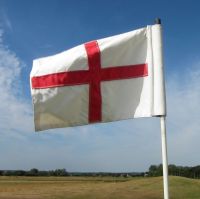Sandwich Ready To Cause Indigestion
/ The weather is shaping up to be the dominant story before a shot is struck, but as Jim McCabe notes, the UK weather forecasts are not only wrong sometimes, but downright fun to analyze.
The weather is shaping up to be the dominant story before a shot is struck, but as Jim McCabe notes, the UK weather forecasts are not only wrong sometimes, but downright fun to analyze.
Doug Ferguson says the current forecast calls for the early/late tee times to get the worst end of the draw.
If that holds true, the players teeing off early Thursday and late Friday could get the worst of it. And as a reminder of how significant the tee times can be, remember that Louis Oosthuizen teed off at 6:41 a.m. in the second round last year at St. Andrews, missed the worst of the weather in his round of 67 and was on his way to a seven-shot win.
Among the early starters Thursday: Rory McIlroy, the overwhelming favorite to add the claret jug to his U.S. Open trophy.
Gary Van Sickle on just how nasty the weather could make Royal St. George's:
The wind is expected to stay up for a few more days, although weather predictions here are even less reliable than Jim Cramer's stock picks.
Factor in the rock-hard, firm-and-fast conditions and a course that gives up quirky bounces, and you've got the recipe for a real blood-letting. The Open at Royal St. George's may turn out to be the penal U.S. Open we didn't get at Congressional, where soft greens caused the John Deere Classic to break out.
Robert Lusetich singles out the holes to watch for R&A setup adjustments based on the morning conditions and on Peter Dawson's admonition Wednesday (“I think players should be able to reach the fairway and reach the par 3s, frankly.")
On Tuesday, Phil Mickelson said he “busted a driver short” on the 11th.
The 11th is a par 3, measuring only 210 yards. Mickelson would normally use a 6-iron to cover that distance, yet into the teeth of a fierce wind one of the longest hitters in the game couldn’t get his driver to the green.
Luke Donald, the world’s No. 1 player, said he couldn’t reach the fairway on the seventh hole.
“That (tee) would need to be put up if the wind was as strong as it was today and in the same direction,” he said.
“Eleven and 13 were also very tough. Eleven was a driver to the par 3, and it was two good shots to get to the front on 13.”
 John Huggan reports that besides getting to see the players make difficult decisions around the green, look for the light rough to breed an unusual tactic on the longer holes.
John Huggan reports that besides getting to see the players make difficult decisions around the green, look for the light rough to breed an unusual tactic on the longer holes.
It is likely also, that some of the more thoughtful -- and accurate -- competitors will deliberately drive into the edge of the rough on some of the longer holes that are playing into the wind. Padraig Harrington is one of those who has long been alive to the possibility of such a tactic.
"If I can drive into the semi-rough off the tee, I'm likely to get a 'flier' lie," explains the two-time Open champion. "From there, I'll be able to hit my next shot much farther than I would from the fairway. When the grass gets between the clubface and the ball, less spin is imparted and I'll be able to run the ball onto greens that would have been out of reach otherwise."
And Bill Fields says this is the essence of The Open which, thankfully is upon us once again.
Having a large time in a wee breeze, on a course that can bite hard, isn't easy, but it's not impossible. "The good thing about the British Open," said Kaymer, "is that you don't have to play, let's say, 'beautiful golf.' You have to score well."
At ground level, though, it helps to see some beauty in the antique land and be intent on solving it. The Open is golf's oldest puzzle, still beguiling after all these years.











